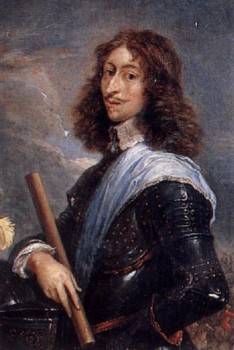Louis, Grand Condé
Reception of the Grand Condé at Versailles following his victory at Seneffe. The Grand Condé advances towards Louis XIV in a respectful manner with laurel wreaths on his path, while captured enemy flags are displayed on both sides of the stairs. It marked the end of Condé’s exile, following his participation to the Fronde.
The term derived from the favored weapons of Paris boys and rioters: slingshots used to hurl stones to break windows and the heads of opponents. Historians disagree as to whether any of the various Fronde were “revolutionary,” even in potential, though that is how they seemed to some contemporaries. These violent political and social upheavals were many things at once, including a rebellion by office-holders against administration reforms and increased fees levied on their bought offices by Mazarin, and before him by Cardinal Armand Richelieu. The increases were needed to pay for wars in Germany (the Thirty Years’ War, which for France lasted from 1635 to 1648) and with Spain (the Franco-Spanish War of 1635-1659). Political plots, street riots, and outright rebellion were also a delayed reaction against the centralizing policies of the monarchy under Mazarin’s great predecessor. The push back was retarded by the need to maintain national unity until the great war in Germany was finally settled in the Peace of Westphalia in 1648. Mazarin provoked rebellion when he ordered the arrest of all office-holders and others who refused to pay new fees and taxes, with violent discontent fueled by rumors that he was personally corrupt. Also in play were the ambitions of great princes and houses, “les grandes,” who were eager to regain class privileges stripped away earlier by the crown. Most notable among the noble rebels were Turenne, an early “Frondeur” who later rejoined the royals, and the Great Condé, who served Louis XIV at first, only later to lead foreign troops and armies against him. The reputations and military abilities of such great nobles, and the willingness of some to call upon Spanish aid in their civil war with the king and Mazarin, raised the stakes and scale of the Fronde from street fights to real battles. There was also an alliance, or at least an association, of several key Frondeurs with the mystical Jansenist movement then roiling the Gallic Church.
The first of the upheavals was the “Fronde parlementaire,” starting in 1648. This was a bloodless movement within the French court system against recent reforms by Mazarin that cut into the privileges of officer-holders. The court Frondeurs turned on the royal tax collectors (intendants) who raised funds to pay for the king’s wars, as well as on the Jews of Paris. This was essentially a conservative, indeed reactionary, movement that wanted to reduce the powers of the Bourbon monarchy and restore traditional privileges, but not displace or overthrow the king. In 1650, the “Fronde princiere” went further, folding into outright rebellion by parts of the nobility and officer corps, including a treacherous alliance with Spanish interests and troops in the border regions. Had it succeeded, the revolt of the princes might have reversed France’s centralization, fragmenting it into a patchwork of sovereign principalities rather like Germany. Mazarin was temporarily expelled from France, while the young Louis XIV and his mother also fled Paris after a mob of frondeurs burst into the royal bedchamber in 1651. It was a fright that the king would neither forget nor forgive when he later built Versailles outside the city and humbled the nobility by making them serve his body, person, and court. For three years, private princely armies fought the monarchy and each other. In 1652 Louis, age 14, proclaimed his majority and returned to Paris. Mazarin raised a royal army and put down the “revolt of the princes,” but he was effectively exiled for another year as part of the price the young king paid to restore civil peace. The princes finally agreed to retire to their country estates, or went into exile.
During these revolts, control of Paris changed hands-from loyalists to rebels and back-more than once. In early 1652, the “Fronde du Bordeaux” spread beyond the nobility and hence was radicalized. Known as the “Ormée,” this Fronde reflected the class influence and issues of angry lawyers and merchants who met under the town’s elm trees (ormes). They declared for a new government that was founded essentially in popular sovereignty-under God, rather than the king. After Paris was recaptured by royalists for the third time in October 1652, the king’s army crushed the revolt in Bordeaux. The city fell to the king’s men in August 1653, ending the Fronde. The most lasting effect of these upheavals was to demonstrate that the alternative to a powerful monarchy under the Bourbons seemed to be civil war, foreign intrigue, and invasion. They thus confirmed the new consolidation of the monarchy and the centralization of power within France, processes which continued apace as Louis XIV entered his maturity.
Suggested Reading: Hubert Méthivier, La Fronde (1984); Orest Ranum, The Fronde (1993).
